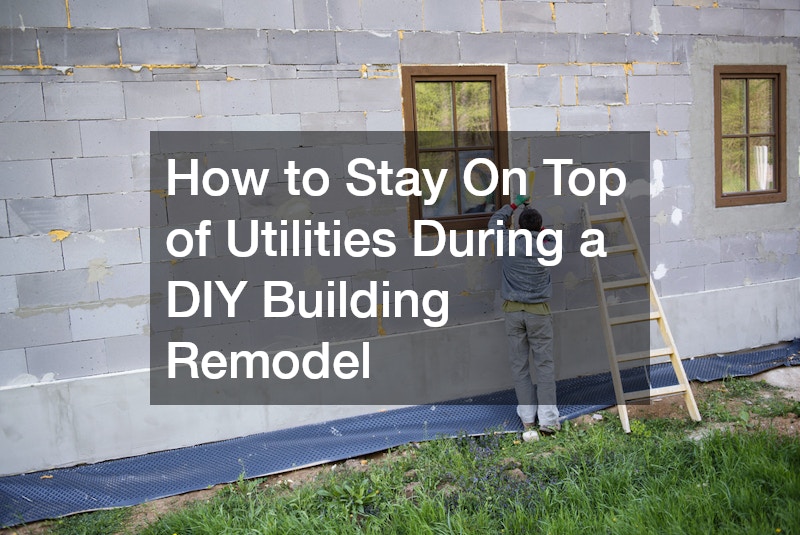Taking on a DIY building remodel can be an exciting project, filled with opportunities to customise your home and add real value to your property. While it’s easy to focus on the big picture of design and style, the hidden aspects of utilities often demand just as much attention. Overlooking these essentials can create stress, delays and unexpected costs, leaving you with a project that takes longer and costs more than planned. Understanding how utilities fit into your overall project allows you to better prepare and keep everything on track.
A remodel involves more than choosing paint colours or finishes. It requires a careful balance of creativity, practicality and planning to ensure the results are not only visually appealing but also functional. By being proactive about utilities, you’ll reduce the chance of last-minute surprises. Knowing how to approach plumbing, cooling and waste systems gives you confidence to manage the scope of work without being overwhelmed. Planning early also allows you to coordinate with professionals when needed, making sure the work aligns with both your budget and schedule. This approach helps you enjoy the process of your building remodel while ensuring your home runs smoothly when it’s complete.
Tackle Hidden Issues

When you’re undertaking a remodel, the last thing you want is a utility problem surfacing at the wrong time. Plumbing, wiring and ventilation are often tucked away behind walls and under floors, which means they can go unnoticed until something goes wrong. Small issues, if left unchecked, can turn into larger repairs that disrupt the progress of your project. Taking the time to inspect these areas before construction starts gives you a clearer picture of what may need attention. This not only protects your investment but also allows for a more efficient remodel experience overall.
One example of an often overlooked issue is a blocked drain. Even minor clogs can create a chain of problems when you’re making structural changes to your home. If left unresolved, drainage issues could cause water to back up during construction, damaging new materials and adding unnecessary repair costs. By organising an inspection before you begin demolition or installation, you’ll reduce the risk of surprises. It’s also wise to make preventative maintenance part of your planning, as a clear plumbing system ensures the rest of your project runs more smoothly.
Manage Indoor Comfort

Remodelling isn’t just about appearances; it’s about creating a comfortable space that serves your everyday needs. Indoor comfort relies heavily on proper ventilation, insulation and climate control, all of which should be considered during planning. Ignoring these systems may result in beautiful rooms that are unpleasant to live in due to poor airflow or inconsistent temperatures. Early planning helps you factor in any upgrades or repairs so your home is as functional as it is attractive.
A prime example is air conditioning. While you may not be replacing your entire system during the remodel, you’ll want to check its efficiency and placement to ensure it still suits your redesigned space. For instance, if walls are being moved or rooms are repurposed, your system may need adjustments to keep airflow balanced. This is also the perfect opportunity to service the unit, check ductwork and assess energy efficiency. Planning these adjustments alongside your remodel ensures that your cooling system continues to work effectively without additional disruptions later.
Maintain Waste Systems

Waste management is often one of the least glamorous parts of a remodel, yet it’s essential for both convenience and safety. An efficient waste system ensures that your home operates without interruption, even as construction work is underway. Planning for waste management during the remodel helps prevent delays, unexpected costs and potential health hazards. It also provides peace of mind knowing that one of your home’s most critical systems won’t let you down when you need it most.
This is where septic pumping becomes a consideration. If your property relies on a septic system, having it serviced before you begin work is a smart move. Heavy machinery, additional workers on site and water usage during construction can place strain on the system. By taking care of maintenance ahead of time, you’ll avoid complications that could otherwise halt progress. Integrating this task into your remodel schedule keeps your utilities running efficiently and ensures your project stays on track without unnecessary interruptions.
Staying on top of utilities is one of the smartest ways to approach a DIY building remodel. By paying attention to hidden issues, planning for comfort and maintaining waste systems, you’ll avoid setbacks that can derail progress. Being proactive ensures that your utilities support the changes you’re making rather than work against them. Whether it’s checking for a blocked drain, making sure your air conditioning is in good order or scheduling septic pumping, these steps safeguard both your investment and your peace of mind. With careful planning, your remodel will be smoother, more efficient and ultimately more rewarding.

